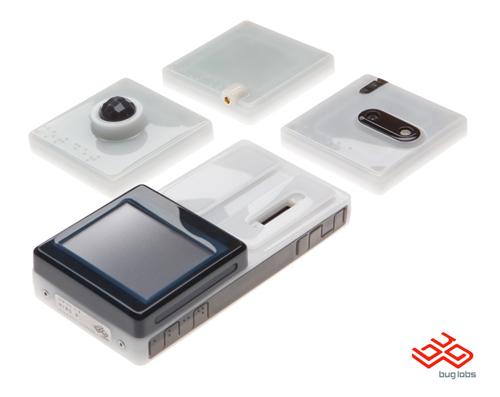
By Evan Ackerman
Last Thursday, Bug Labs had a little party at a bar in San Francisco to show off their new, well, I’m not sure what to call it… Multigadget? Nah, I like übergadget better. Anyway, drinks were on them, so I showed up to check it out.
Explaining what BUG actually is can be a bit tricky, because Bug Labs isn’t really marketing one specific product. In a nutshell, BUG is a collection of hardware modules that plug into a common base and are united by open-source software. You can combine the modules and write or download software to create pretty much any gadget you want with the BUG system. If that doesn’t make sense, here’s an example from the BUG website… Say you want a digital camera that automatically geotags your pictures, and then emails them to your family and friends. Just plug a camera module, a viewscreen module, and a GPS module into the base, find the right software, and you’re good to go. Want to add text descriptions to the pictures? Plug in a keyboard module. Audio descriptions? Audio module. Done taking pictures and want a Nintendo DS emulator? Unplug the camera and GPS stuff, and plug in two viewscreens (they’re also touchscreens). Taking a trip? How about an audio module, a viewscreen module, some extra storage, and an extra battery… You’ve just made yourself a PMP. I mean, the possibilities are limitless with this thing. Here’s a video kinda showing how BUG works. Sorry about the poor quality, but it was dark and noisy:
The downside, at this point, is that BUG is not ready for the average consumer to just pick up and run with. Although it will come with some built-in basic functionality at launch, the whole point of BUG is to provide a framework within which users can design their own software (and, to some extent, hardware) to get BUG to do exactly what they want it to do. So unless you’ve got a good understanding of Java, BUG is probably not the gadget for you. If you DO know how to program, Bug Labs has made it very, very easy to work with the built-in hardware integration that BUG offers. Working versions of BUG should be available to beta testers before 2008, and when BUG launches sometime next year, it should cost somewhere in the “hundreds” of dollars. Not being a Java whiz myself, I’m looking forward to next year sometime (I hope) when enough of an open source BUG software library has been created that I’ll be able to just download whatever I need. And hey, if nothing else, BUG is a pretty darn good incentive to learn Java, right?
More detailed specs on the base and modules after the jump.
The BUG Base is 2″ x 4.” It runs on Linux and includes a processor, 128MB RAM, built-in WiFi (b/g), a rechargeable battery, USB 2.0, Ethernet, a small LCD with button controls, a tripod mount, and an MMC (because it’s open source) slot. At the demo, they had functional QVGA color touchscreen LCD modules, a camera module (does stills and video), a GPS module, and a motion sensor / accelerometer. By next year, they’ll be adding a double-module widescreen touch-sensitive LCD, a mini-QWERTY keyboard, an audio in/out module with an integrated speaker, and a teleportation module. Wait, what?
[ Bug Labs ]










